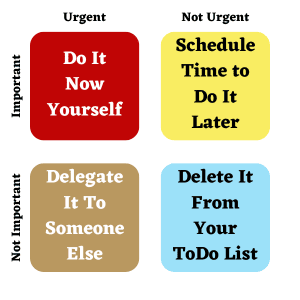In the ever-accelerating pace of modern life, juggling tasks, responsibilities, and priorities can often feel like trying to solve a Rubik's Cube blindfolded. Amidst the chaos, finding a method to organize and prioritize tasks becomes paramount. Enter the Eisenhower Matrix, a powerful productivity tool named after the 34th President of the United States, Dwight D. Eisenhower, who famously said, "What is important is seldom urgent, and what is urgent is seldom important."
At its core, the Eisenhower Matrix is a simple yet effective framework for categorizing tasks based on their urgency and importance. It consists of four quadrants:

Urgent and Important (Do): Tasks falling into this quadrant are both urgent and important, demanding immediate attention. These could include pressing deadlines, critical issues, or emergencies. They require prompt action and are non-negotiable in terms of prioritization.
Important, but Not Urgent (Schedule): This quadrant is reserved for tasks that are important for long-term goals, personal development, or strategic planning but don't require immediate attention. Examples might include long-term projects, relationship-building activities, or skill development. Though not pressing, these tasks should be scheduled and allocated time for completion.
Urgent, but Not Important (Delegate): Tasks in this quadrant are urgent but lack long-term significance or value. They often involve interruptions, minor issues, or tasks that can be delegated to others. While they may seem pressing, they can often distract from more meaningful work. Delegating these tasks whenever possible allows you to focus on higher-priority activities.
Not Urgent and Not Important (Eliminate): The final quadrant encompasses tasks that neither demand immediate attention nor contribute to long-term goals. These tasks are often distractions, time-wasters, or trivial activities that provide little to no value. Eliminating or minimizing these tasks frees up valuable time and mental energy for more meaningful endeavors.

